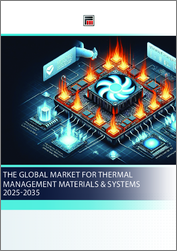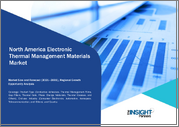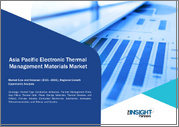
|
시장보고서
상품코드
1567374
세계의 열관리 재료 및 시스템 시장(2025-2035년)The Global Market for Thermal Management Materials and Systems 2025-2035 |
||||||
열관리 재료 및 시스템 시장은 여러 부문에서 큰 성장세를 보이고 있습니다. 주요 시장 부문으로는 CE(Consumer Electronics), 전기자동차, 데이터센터, ADAS 센서, EMI 차폐, 5G/6G 통신, 항공우주, 에너지 시스템 등이 있습니다. 이 시장에는 그리스, 젤, 페이스트, 상변화물질(PCM), 열 패드, 갭 필러, 접착제, 탄소계 재료, 금속 솔루션 등 열전도 재료(TIM)를 포함한 다양한 재료가 포함됩니다.
전기자동차는 배터리, 파워 일렉트로닉스, 모터를 위한 첨단 열관리 솔루션에 대한 수요가 증가하고 있는 역동적인 분야로, 800V 아키텍처와 고출력 충전 시스템으로의 전환은 냉각 기술의 혁신을 촉진하고 있습니다. 데이터센터도 중요한 시장이며, 전력 밀도 증가로 인해 보다 효과적인 냉각 솔루션이 요구되고 있습니다. 액침냉각 및 하이브리드 시스템으로의 추세는 보다 효율적인 열 관리 접근 방식에 대한 업계의 요구를 반영하고 있으며, 5G/6G 인프라의 등장은 특히 안테나 시스템 및 기지국에서 새로운 열 문제를 야기하고 있습니다. 마찬가지로 ADAS 센서 시장은 센서 기능의 확장으로 인해 점점 더 진보된 열 솔루션이 요구되고 있으며, 2035년까지 모든 부문에서 강력한 성장 잠재력을 보여주고 있으며, 특히 다음과 같은 분야에 중점을 두고 있습니다.
- 열전도율이 높은 첨단 소재
- 통합형 냉각 시스템
- 지속가능하고 친환경적인 솔루션
- AI/ML 기능이 탑재된 스마트 열관리 시스템
- 액침냉각 및 상 변화 재료와 같은 새로운 접근 방식
세계의 열관리 재료 및 시스템 시장에 대해 조사했으며, 빠르게 진화하는 산업에 대한 상세한 인사이트와 2035년까지 시장 예측, 기술 개발, 경쟁 구도를 포함한 종합적인 분석을 전해드립니다.
목차
제1장 서론
- 열관리
- 열관리 시스템
- 열관리 재료와 기술의 주요 유형
제2장 열전도 재료
- 열전도 재료(TIM)란?
- TIM의 비교 특성
- TIM의 이점과 결점 : 유형별
- 가격
- 서멀 그리스, 페이스트
- 서멀 갭 패드
- 서멀 갭 필러
- 열접착제, 포팅재
- 금속 기반 TIM
- 탄소 기반 TIM
- 메타물질
- 자기치유 열전도 재료
- 상변화 열전도 재료(PCTIM)
- 세계 시장 예측(2020-2035년)
제3장 히트 스프레더, 히트 싱크
- 설계
- 재료
- 과제
- 시장 예측
제4장 액랭 시스템
- 설계
- 유형
- 액랭 시스템의 컴포넌트
- 데이터센터의 냉각
- 이점
- 과제
- 시장 예측
제5장 공랭
- 서론
- 공랭 방식
- 상업 예
- 물과 전력 소비의 최적화
- 용도
- 시장 예측
제6장 냉각 플레이트
- 개요
- 설계
- 강화법
- 용도
- 시장 예측
제7장 스프레이 냉각
- 개요
- 열전도 메커니즘
- 스프레이 냉각액
- 용도
- 시장 예측
제8장 액침냉각
- 개요
- 일반적인 침지액
- 이점
- 단상 액침냉각
- 2상 액침냉각
- 상업 예
- 비용
- 과제
- 시장 예측
제9장 열전냉각기
- 열전모듈
- 성능 요인
- 전자기기 냉각
제10장 냉각액
- 개요
- EV
- 액침냉각의 채택 확대
- 시장 예측
제11장 상변화물질
- 상변화물질(PCM)의 특성
- 유형
- 열에너지 저장(TES)
- 배터리 열관리
- 시장 예측
제12장 열관리 재료·시스템 시장
- CE(Consumer Electronics)
- 시장 개요
- 시장 성장 촉진요인
- 용도
- 세계 시장의 매출(2020-2035년)
- 전기자동차(EV)
- 개요
- 전기자동차 열시스템 아키텍처와 컴포넌트
- 상용차용 열관리 시스템
- 시장 성장 촉진요인
- EV 냉각
- 전기 모터
- 파워 일렉트로닉스
- 충전소
- 세계 시장의 매출(2020-2035년)
- 데이터센터
- 시장 개요
- 시장 성장 촉진요인
- 데이터센터 열관리 요건
- 데이터센터 냉각
- 용도
- 세계 시장의 매출(2020-2035년)
- ADAS 센서
- 시장 개요
- 시장 성장 촉진요인
- 용도
- 세계 시장의 매출(2020-2035년)
- EMI 차폐
- 시장 개요
- 시장 성장 촉진요인
- 용도
- 세계 시장의 매출(2020-2035년)
- 5G/6G
- 시장 개요
- 시장 성장 촉진요인
- 용도
- 세계 시장의 매출(2020-2035년)
- 항공우주
- 시장 개요
- 시장 성장 촉진요인
- 용도
- 세계 시장의 매출(2020-2035년)
- 에너지 시스템
- 시장 개요
- 시장 성장 촉진요인
- 용도
- 세계 시장의 매출(2020-2035년)
- 기타 시장
- 첨단 로봇
제13장 세계의 매출
- 세계의 매출 : 유형별(2023년)
- 세계의 매출 : 재료별(2024-2035년)
- 최종 용도 시장별
- 지역별
제14장 향후 시장 전망
제15장 기업 개요(기업 169사의 개요)
제16장 조사 방법
제17장 참고 문헌
KSA 25.02.04The thermal management materials and systems market is experiencing significant growth driven by multiple sectors. Key market segments include consumer electronics, electric vehicles, data centers, ADAS sensors, EMI shielding, 5G/6G telecommunications, aerospace, and energy systems. The market features diverse materials including thermal interface materials (TIMs) such as greases, gels, pastes, phase change materials (PCMs), thermal pads, gap fillers, adhesives, carbon-based materials, and metallic solutions.
Electric vehicles represent a particularly dynamic segment, with increasing demand for sophisticated thermal management solutions for batteries, power electronics, and motors. The transition to 800V architectures and higher-power charging systems is driving innovation in cooling technologies. Data centers are another crucial market, with growing power densities necessitating more effective cooling solutions. The trend toward immersion cooling and hybrid systems reflects the industry's need for more efficient thermal management approaches. The emergence of 5G/6G infrastructure has created new thermal challenges, particularly in antenna systems and base stations. Similarly, the ADAS sensor market requires increasingly sophisticated thermal solutions as sensor capabilities expand. Looking toward 2035, the market shows strong growth potential across all segments, with particular emphasis on:
- Advanced materials with higher thermal conductivity
- Integrated cooling systems
- Sustainable and environmentally friendly solutions
- Smart thermal management systems with AI/ML capabilities
- Novel approaches like immersion cooling and phase change materials
"The Global Thermal Management Materials and Systems 2025-2035" provides detailed insights into the rapidly evolving thermal management materials and systems industry, covering crucial applications across electric vehicles, data centers, consumer electronics, and emerging technologies. The comprehensive analysis includes market forecasts, technological developments, and competitive landscapes through 2035.
Report contents in:
- In-depth analysis of thermal interface materials (TIMs), including greases, phase change materials, thermal pads, and advanced carbon-based solutions
- Detailed examination of cooling technologies: liquid cooling, air cooling, immersion cooling, and hybrid systems
- Comprehensive coverage of electric vehicle thermal management, including battery, power electronics, and motor cooling solutions
- Analysis of data center cooling trends, from traditional air cooling to advanced immersion systems
- Evaluation of emerging technologies in 5G/6G infrastructure cooling
- Assessment of aerospace and defense thermal management applications
- Market opportunities in ADAS sensors and EMI shielding
- Market size and growth projections
- Technology trends and innovation analysis
- Competitive landscape and company profiles. Companies profiled include 3M, Accelsius, ADA Technologies, Adept Materials, Airthium, Aismalibar, AI Technology, Amphenol Advanced Sensors, Andores New Energy, AOK Technologies, AOS Thermal Compounds, Apheros, Arkema, Arieca, Arteco, Asahi Kasei, Aspen Aerogels, Asperitas, ATP Adhesive Systems, Axalta Coating Systems, Axiotherm, Azelio, Bando Chemical Industries, Beam Global, BNNano, BNNT LLC, Boyd Corporation, BYK, Cadenza Innovation, Calyos, Carrar, Carbice Corp, Carbon Waters, Carbodeon, Chilldyne, Climator Sweden, CondAlign, Croda Europe, Cryopak, Dana, Datum Phase Change, Detakta, Devan Chemicals, Dexerials, Dober, Dow Corning, Dupont (Laird Performance Materials), Dymax, ELANTAS Europe, Deyang Carbonene Technology, Elkem Silicones, e-Mersiv, Elkem, Enerdyne Thermal Solutions, Engineered Fluids, Epoxies Etc, Ewald Dorken AG, Exergyn, First Graphene, FUCHS, Fujipoly, Fujitsu Laboratories, GLPOLY, Global Graphene Group, Graphmatech, Green Revolution Cooling (GRC), GuangDong KingBali, HALA Contec, Hamamatsu Carbonics, Goodfellow, Hangzhou Ruhr New Material Technology, H.B. Fuller, HeatVentors, Henkel, Honeywell, Huber Martinswerk, HyMet Thermal Interfaces, Iceotope, Immersion4, Indium Corporation, Inkron, Inuteq, JetCool Technologies, JIOS Aerogel, Kerafol, Kitagawa, KULR Technology Group, Leader Tech, LiquidCool Solutions, LiquidStack, Liquid Wire, LiSAT, MAHLE, Materium Technologies and more.
- Regional market analysis
- Application-specific requirements and solutions
- Material developments and emerging technologies
- Regulatory framework and environmental considerations
Detailed segments covered include:
- Thermal Interface Materials
- Heat Spreaders and Heat Sinks
- Liquid Cooling Systems
- Air Cooling Solutions
- Cooling Plates
- Spray Cooling Technology
- Immersion Cooling Systems
- Phase Change Materials
- Coolant Fluids
Applications analyzed include:
- Electric Vehicle Battery Systems
- Data Center Infrastructure
- Consumer Electronics
- 5G/6G Communications
- Aerospace Systems
- ADAS Sensors
- Power Electronics
- EMI Shielding
TABLE OF CONTENTS
1. INTRODUCTION
- 1.1. Thermal management
- 1.1.1. Active
- 1.1.2. Passive
- 1.2. Thermal Management Systems
- 1.2.1. Immersion Cooling Systems for Data Centers
- 1.2.2. Battery Thermal Management for Electric Vehicles
- 1.2.3. Heat Exchangers for Aerospace Cooling
- 1.2.4. Air Cooling Systems
- 1.2.5. Liquid Cooling Systems
- 1.2.6. Vapor Compression Systems
- 1.2.7. Spray Cooling Systems
- 1.2.8. Hybrid Cooling Systems
- 1.2.8.1. Hybrid Liquid-to-Air Cooling
- 1.2.8.2. Hybrid Liquid-to-Liquid Cooling
- 1.2.8.3. Hybrid Liquid-to-Refrigerant Cooling
- 1.2.8.4. Hybrid Refrigerant-to-Refrigerant Cooling
- 1.3. Main types of thermal management materials and technologies
2. THERMAL INTERFACE MATERIALS
- 2.1. What are thermal interface materials (TIMs)?
- 2.1.1. Types
- 2.1.2. Thermal conductivity
- 2.2. Comparative properties of TIMs
- 2.3. Advantages and disadvantages of TIMs, by type
- 2.4. Prices
- 2.5. Thermal greases and pastes
- 2.6. Thermal gap pads
- 2.7. Thermal gap fillers
- 2.8. Thermal adhesives and potting compounds
- 2.9. Metal-based TIMs
- 2.9.1. Solders and low melting temperature alloy TIMs
- 2.9.2. Liquid metals
- 2.9.3. Solid liquid hybrid (SLH) metals
- 2.9.3.1. Hybrid liquid metal pastes
- 2.9.3.2. SLH created during chip assembly (m2TIMs)
- 2.10. Carbon-based TIMs
- 2.10.1. Multi-walled nanotubes (MWCNT)
- 2.10.1.1. Properties
- 2.10.1.2. Application as thermal interface materials
- 2.10.2. Single-walled carbon nanotubes (SWCNTs)
- 2.10.2.1. Properties
- 2.10.2.2. Application as thermal interface materials
- 2.10.3. Vertically aligned CNTs (VACNTs)
- 2.10.3.1. Properties
- 2.10.3.2. Applications
- 2.10.3.3. Application as thermal interface materials
- 2.10.4. BN nanotubes (BNNT) and nanosheets (BNNS)
- 2.10.4.1. Properties
- 2.10.4.2. Application as thermal interface materials
- 2.10.5. Graphene
- 2.10.5.1. Properties
- 2.10.5.2. Application as thermal interface materials
- 2.10.5.2.1. Graphene fillers
- 2.10.5.2.2. Graphene foam
- 2.10.5.2.3. Graphene aerogel
- 2.10.6. Nanodiamonds
- 2.10.6.1. Properties
- 2.10.6.2. Application as thermal interface materials
- 2.10.7. Graphite
- 2.10.7.1. Properties
- 2.10.7.2. Natural graphite
- 2.10.7.2.1. Classification
- 2.10.7.2.2. Processing
- 2.10.7.2.3. Flake
- 2.10.7.2.3.1. Grades
- 2.10.7.2.3.2. Applications
- 2.10.7.3. Synthetic graphite
- 2.10.7.3.1. Classification
- 2.10.7.3.1.1. Primary synthetic graphite
- 2.10.7.3.1.2. Secondary synthetic graphite
- 2.10.7.3.1.3. Processing
- 2.10.7.3.1. Classification
- 2.10.7.4. Applications as thermal interface materials
- 2.10.8. Hexagonal Boron Nitride
- 2.10.8.1. Properties
- 2.10.8.2. Application as thermal interface materials
- 2.10.1. Multi-walled nanotubes (MWCNT)
- 2.11. Metamaterials
- 2.11.1. Types and properties
- 2.11.1.1. Thermal metamaterials
- 2.11.1.2. Electromagnetic metamaterials
- 2.11.1.2.1. Double negative (DNG) metamaterials
- 2.11.1.2.2. Single negative metamaterials
- 2.11.1.2.3. Electromagnetic bandgap metamaterials (EBG)
- 2.11.1.2.4. Bi-isotropic and bianisotropic metamaterials
- 2.11.1.2.5. Chiral metamaterials
- 2.11.1.2.6. Electromagnetic "Invisibility" cloak
- 2.11.1.3. Terahertz metamaterials
- 2.11.1.4. Photonic metamaterials
- 2.11.1.5. Tunable metamaterials
- 2.11.1.6. Frequency selective surface (FSS) based metamaterials
- 2.11.1.7. Nonlinear metamaterials
- 2.11.1.8. Acoustic metamaterials
- 2.11.2. Application as thermal interface materials
- 2.11.1. Types and properties
- 2.12. Self-healing thermal interface materials
- 2.12.1. Extrinsic self-healing
- 2.12.2. Capsule-based
- 2.12.3. Vascular self-healing
- 2.12.4. Intrinsic self-healing
- 2.12.5. Healing volume
- 2.12.6. Types of self-healing materials, polymers and coatings
- 2.12.7. Applications in thermal interface materials
- 2.13. Phase change thermal interface materials (PCTIMs)
- 2.13.1. Thermal pads
- 2.13.2. Low Melting Alloys (LMAs)
- 2.14. Global Market forecast 2020-2035
3. HEAT SPREADERS AND HEAT SINKS
- 3.1. Design
- 3.2. Materials
- 3.2.1. Aluminum alloys
- 3.2.2. Copper
- 3.2.3. Metal foams
- 3.2.4. Metal matrix composites
- 3.2.5. Graphene
- 3.2.6. Carbon foams and nanotubes
- 3.2.7. Graphite
- 3.2.8. Diamond
- 3.2.9. Liquid immersion cooling
- 3.2.10. Applications
- 3.3. Challenges
- 3.4. Market forecast
4. LIQUID COOLING SYSTEMS
- 4.1. Design
- 4.2. Types
- 4.3. Components of Liquid Cooling Systems
- 4.4. Cooling in Data Centers
- 4.4.1. Rack Level
- 4.4.2. Chip Level
- 4.5. Benefits
- 4.6. Challenges
- 4.7. Market forecast
5. AIR COOLING
- 5.1. Introduction
- 5.2. Air Cooling Methods
- 5.3. Commercial examples
- 5.4. Optimization of water and power consumption
- 5.5. Applications
- 5.6. Market forecast
6. COOLING PLATES
- 6.1. Overview
- 6.1.1. Advanced cooling plates
- 6.1.2. Roll Bond Aluminium Cold Plates
- 6.1.3. Cold Plate Design
- 6.1.4. Commercial examples
- 6.1.5. Graphite heat spreaders
- 6.1.5.1. Commercial examples
- 6.1.6. Cold Plate/Direct to Chip Cooling
- 6.1.7. Liquid Cooling Cold Plates
- 6.1.8. Single-Phase Cold Plate
- 6.1.8.1. Commercial examples
- 6.1.9. Two-Phase Cold Plate
- 6.1.9.1. Commercial examples
- 6.2. Design
- 6.3. Enhancement Techniques
- 6.3.1. Cost
- 6.4. Applications
- 6.5. Market forecast
7. SPRAY COOLING
- 7.1. Overview
- 7.2. Heat Transfer Mechanisms
- 7.3. Spray Cooling Fluids
- 7.4. Applications
- 7.5. Market forecast
8. IMMERSION COOLING
- 8.1. Overview
- 8.2. Common immersion fluids
- 8.3. Benefits
- 8.4. Single-Phase Immersion Cooling
- 8.5. Two-Phase Immersion Cooling
- 8.6. Commercial examples
- 8.7. Costs
- 8.8. Challenges
- 8.9. Market forecast
9. THERMOELECTRIC COOLERS
- 9.1. Thermoelectric Modules
- 9.2. Performance Factors
- 9.3. Electronics Cooling
10. COOLANT FLUIDS
- 10.1. Overview
- 10.1.1. Properties
- 10.1.1.1. Electrical
- 10.1.1.2. Corrosion
- 10.1.1.3. Viscosity reduction
- 10.1.1. Properties
- 10.2. EVs
- 10.2.1. Coolant Fluid Requirements
- 10.2.2. Common EV Coolant Fluids
- 10.2.3. Commercial examples
- 10.2.4. Refrigerants for EVs
- 10.2.5. EV coolant fluid trends
- 10.2.6. Design Considerations
- 10.3. Growing adoption of immersion cooling
- 10.4. Market forecast
11. PHASE CHANGE MATERIALS
- 11.1. Properties of Phase Change Materials (PCMs)
- 11.2. Types
- 11.2.1. Organic/biobased phase change materials
- 11.2.1.1. Advantages and disadvantages
- 11.2.1.2. Paraffin wax
- 11.2.1.3. Non-Paraffins/Bio-based
- 11.2.2. Inorganic phase change materials
- 11.2.2.1. Salt hydrates
- 11.2.2.1.1. Advantages and disadvantages
- 11.2.2.2. Metal and metal alloy PCMs (High-temperature)
- 11.2.2.1. Salt hydrates
- 11.2.3. Eutectic mixtures
- 11.2.4. Encapsulation of PCMs
- 11.2.4.1. Macroencapsulation
- 11.2.4.2. Micro/nanoencapsulation
- 11.2.5. Nanomaterial phase change materials
- 11.2.1. Organic/biobased phase change materials
- 11.3. Thermal energy storage (TES)
- 11.3.1. Sensible heat storage
- 11.3.2. Latent heat storage
- 11.4. Battery Thermal Management
- 11.5. Market forecast
12. MARKETS FOR THERMAL MANAGEMENT MATERIALS AND SYSTEMS
- 12.1. Consumer electronics
- 12.1.1. Market overview
- 12.1.2. Market drivers
- 12.1.3. Applications
- 12.1.3.1. Smartphones and tablets
- 12.1.3.2. Wearable electronics
- 12.1.4. Global market revenues 2020-2035
- 12.2. Electric Vehicles (EV)
- 12.2.1. Overview
- 12.2.2. Electric vehicle thermal system architecture and components
- 12.2.3. Commercial vehicle thermal management systems
- 12.2.3.1. Transition to 800V architecture
- 12.2.4. Market drivers
- 12.2.5. EV Cooling
- 12.2.5.1. Coolant Fluids
- 12.2.5.1.1. Properties
- 12.2.5.1.2. Integration of battery and eAxle cooling
- 12.2.5.2. Refrigerants
- 12.2.5.2.1. PFAS Free Refrigerants
- 12.2.5.2.2. The integration of heat pump systems in EVs
- 12.2.5.3. Active vs Passive Cooling
- 12.2.5.4. Air Cooling
- 12.2.5.5. Liquid Cooling
- 12.2.5.6. Refrigerant Cooling
- 12.2.5.7. Cell-to-pack designs
- 12.2.5.8. Cell-to-chassis/body
- 12.2.5.9. Immersion Cooling
- 12.2.5.9.1. Phase Change Materials
- 12.2.5.9.2. Commercial examples
- 12.2.5.9.3. Operating Temperature
- 12.2.5.10. Heat Spreaders and Cooling Plates
- 12.2.5.10.1. Heat spreader technology
- 12.2.5.10.1.1. Commercial examples
- 12.2.5.10.1.2. Graphite Heat Spreaders
- 12.2.5.10.2. Advanced cold plates
- 12.2.5.10.2.1. Commercial examples
- 12.2.5.10.2.2. Integration of cold plates into battery enclosures
- 12.2.5.10.3. Polymer Heat Exchangers
- 12.2.5.10.1. Heat spreader technology
- 12.2.5.11. Coolant Hoses
- 12.2.5.12. Thermal Interface Materials
- 12.2.5.13. Fire Protection Materials
- 12.2.5.13.1. Overview
- 12.2.5.13.2. Thermal runaway in electric vehicles
- 12.2.5.13.3. Vehicle fires
- 12.2.5.13.4. Regulations
- 12.2.5.14. Printed Sensors
- 12.2.5.15. Other cooling
- 12.2.5.1. Coolant Fluids
- 12.2.6. Electric motors
- 12.2.6.1. Air Cooling
- 12.2.6.2. Water-glycol Cooling
- 12.2.6.3. Oil Cooling
- 12.2.6.4. Advanced cooling structures
- 12.2.6.4.1. Refrigerant Cooling
- 12.2.6.4.2. Immersion Cooling
- 12.2.6.5. Motor Insulation and Encapsulation
- 12.2.6.5.1. Commercial activity
- 12.2.6.5.2. Axial Flux Motors
- 12.2.6.5.3. In-wheel Motors
- 12.2.7. Power electronics
- 12.2.7.1. Overview
- 12.2.7.2. Technology and materials evolution
- 12.2.7.3. Power module packaging technology
- 12.2.7.4. Single- vs Double-Sided Cooling
- 12.2.7.5. TIMs in Power Electronics
- 12.2.7.5.1. Thermal Interface Material 1 (TIM1)
- 12.2.7.5.2. Thermal Interface Material 2 (TIM2)
- 12.2.7.6. Wire Bonding
- 12.2.7.7. Substrate Materials
- 12.2.7.8. Cooling Power Electronics
- 12.2.7.8.1. Inverter package cooling
- 12.2.7.8.2. Direct cooling
- 12.2.8. Charging stations
- 12.2.8.1.1. Charging Levels
- 12.2.8.1.2. Liquid Cooling
- 12.2.8.1.3. Commercial examples
- 12.2.8.1.4. Immersion Cooling
- 12.2.8.2. Cabin heating
- 12.2.8.3. Heat Pumps
- 12.2.9. Global Market Revenues 2020-2035
- 12.3. Data Centers
- 12.3.1. Market overview
- 12.3.2. Market drivers
- 12.3.3. Data Center thermal management requirements
- 12.3.3.1. Increase in Thermal Design Power (TDP)
- 12.3.3.2. Energy Efficiency
- 12.3.4. Data Center Cooling
- 12.3.4.1. Cooling Technology
- 12.3.4.2. Air Cooling
- 12.3.4.3. Hybrid Liquid-to-Air Cooling (L2A)
- 12.3.4.4. Hybrid Liquid-to-Liquid Cooling (L2L)
- 12.3.4.5. Hybrid Liquid-to-Refrigerant Cooling
- 12.3.4.6. Hybrid Refrigerant-to-Refrigerant Cooling
- 12.3.4.7. Thermal Interface Materials
- 12.3.4.7.1. Data center power supplies
- 12.3.4.8. Cold plates
- 12.3.4.9. Spray Cooling
- 12.3.4.10. Immersion Cooling
- 12.3.5. Applications
- 12.3.5.1. Router, switches and line cards
- 12.3.5.2. Servers
- 12.3.5.3. Power supply converters
- 12.3.6. Global Market Revenues 2020-2035
- 12.4. ADAS Sensors
- 12.4.1. Market overview
- 12.4.2. Market drivers
- 12.4.3. Applications
- 12.4.3.1. ADAS Cameras
- 12.4.3.2. ADAS Radar
- 12.4.3.3. ADAS LiDAR
- 12.4.4. Global Market Revenues 2020-2035
- 12.5. EMI shielding
- 12.5.1. Market overview
- 12.5.2. Market drivers
- 12.5.3. Applications
- 12.5.4. Global Market Revenues 2020-2035
- 12.6. 5G/6G
- 12.6.1. Market overview
- 12.6.2. Market drivers
- 12.6.3. Applications
- 12.6.3.1. Antenna
- 12.6.3.2. Base Band Unit (BBU)
- 12.6.4. Global Market Revenues 2020-2035
- 12.7. Aerospace
- 12.7.1. Market overview
- 12.7.2. Market drivers
- 12.7.3. Applications
- 12.7.4. Global Market Revenues 2020-2035
- 12.8. Energy systems
- 12.8.1. Market overview
- 12.8.2. Market drivers
- 12.8.3. Applications
- 12.8.4. Global Market Revenues 2020-2035
- 12.9. Other markets
- 12.9.1. Advanced Robotics
- 12.9.1.1. Design Considerations
- 12.9.1.2. Implementation Strategies
- 12.9.1.3. Advanced Cooling Technologies
- 12.9.1.4. Environmental Considerations
- 12.9.1.5. Future Trends
- 12.9.1. Advanced Robotics
13. GLOBAL REVENUES
- 13.1. Global revenues 2023, by type
- 13.2. Global revenues 2024-2035, by materials type
- 13.2.1. Telecommunications market
- 13.2.2. Electronics and data centers market
- 13.2.3. ADAS market
- 13.2.4. Electric vehicles (EVs) market
- 13.3. By end-use market
- 13.4. By region



















